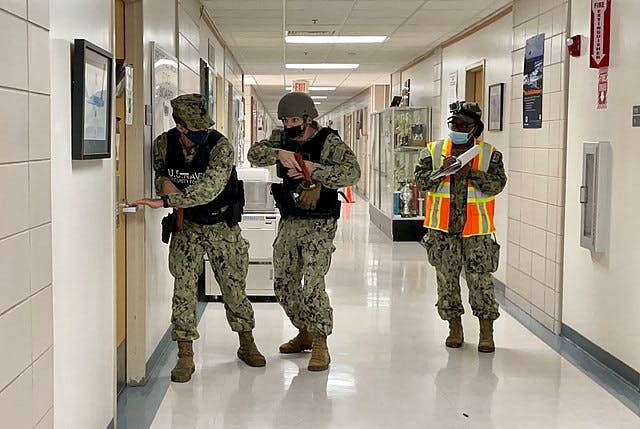Professional Active Shooter Training Strategies and Techniques
Professional Active Shooter Training Strategies and Techniques
Blog Article
Effective Approaches and Strategies in Energetic Shooter Training for Improved Security
In today's ever-evolving protection landscape, the significance of preparedness and effective action methods in the face of energetic shooter incidents can not be overstated. By diving right into the ins and outs of each of these elements and checking out how they can work in harmony, an extra efficient and robust active shooter training program can be established to improve safety and security actions.
Danger Evaluation and Danger Evaluation
Reliable threat evaluation and comprehensive danger analysis are fundamental components in boosting protection measures during energetic shooter training programs. By performing a detailed threat assessment, organizations can create and identify potential susceptabilities targeted approaches to alleviate threats connected with energetic shooter events. This process includes evaluating elements such as facility design, accessibility points, protection systems, and emergency procedures to create a detailed understanding of the certain hazards encountered by the organization.
Risk analysis plays an essential role in active shooter training programs by determining potential enemies, their abilities, and their intents. This details is used to design realistic training situations that simulate the tactics and behaviors of possible enemies, enabling participants to practice appropriate responses in a regulated environment. By integrating risk analysis into training exercises, companies can better prepare their personnel to acknowledge and respond efficiently to active shooter scenarios.
Dilemma Interaction and Response Plans
Because of the extensive risk evaluation and comprehensive threat analysis conducted during active shooter training programs, a vital facet that organizations have to attend to is the growth of crisis interaction and reaction plans. These strategies are important for making sure a worked with and reliable action to an active shooter situation, decreasing prospective harm to individuals, and improving total protection actions.
Reliable crisis interaction strategies should describe clear methods for distributing details to all stakeholders, consisting of employees, site visitors, law enforcement, and the media. Accurate and timely interaction is critical in taking care of the situation, supplying instructions on exactly how to stay safe, and stopping panic or misinformation from spreading.
Reaction plans, on the various other hand, detail the certain activities that people should take in the occasion of an active shooter occurrence. Routine training, drills, and updates to these plans are vital to guarantee their efficiency and the security of every person involved.
Energetic Shooter Circumstance Drills
Performing routine active shooter circumstance drills is crucial for preparing people and companies to respond efficiently in high-stress situations. These drills simulate real-life energetic shooter scenarios, allowing participants to exercise their actions and assess the performance of their training and emergency situation protocols (active shooter training). By performing these drills, people can acquaint themselves with the noise of substitute gunfire, technique lockdown procedures, evacuation routes, and communication techniques
Energetic shooter situation drills likewise aid in recognizing possible weaknesses in safety and security procedures and feedback strategies. Via these simulations, organizations can examine the performance of their security protocols, interaction systems, and control amongst personnel. Performing these drills frequently can aid in you could try these out refining existing treatments, like this implementing enhancements, and making sure that all individuals are prepared to act quickly and emphatically in case of an energetic shooter event.

Emergency Medical Training and First Help
Enhancing readiness for emergency situations, including active shooter cases, necessitates comprehensive training in emergency clinical treatments and emergency treatment. In case of an active shooter circumstance, individuals learnt emergency medical procedures can provide vital aid to those wounded until specialist clinical aid shows up. Very first help training gears up individuals with the expertise and skills to carry out prompt treatment, support individuals, and possibly save lives.
Key parts of emergency clinical training include learning how to regulate blood loss, apply tourniquets, do mouth-to-mouth resuscitation, and deal with different injuries. Individuals additionally learn just how to focus on care based upon the seriousness of injuries and the readily available resources. Moreover, training in emergency treatment helps people continue to be tranquil and concentrated during disorderly scenarios, enabling them to make informed and fast decisions under stress.

Psychological Assistance and Trauma Care
Supplying mental support and injury treatment is vital in minimizing the psychological effect of emergency circumstances, such as energetic shooter events. When people experience such stressful events, they might suffer from an array of emotional distress, including anxiety, clinical depression, and post-traumatic stress condition (PTSD) Therefore, it is critical to have actually educated experts readily available to use prompt assistance and treatments to assist people deal with the after-effects of such dilemmas.
Psychological very first investigate this site aid is a key element of reacting to active shooter incidents. This strategy involves giving practical aid, psychological support, and coping methods to those impacted by the trauma. By resolving the mental requirements of individuals quickly, the possibility of long-term unfavorable results can be lowered, and people can begin the procedure of healing and recovery.
In enhancement to immediate emotional support, recurring trauma treatment is vital for those impacted by active shooter occurrences. This may include accessibility to counseling solutions, support groups, and various other resources to assist people navigate the complicated emotions and difficulties that can occur complying with such terrible events. By focusing on psychological assistance and injury treatment in energetic shooter training programs, companies can better prepare individuals to cope with the emotional aftermath of such emergency situations.
Conclusion
In final thought, efficient strategies and techniques in energetic shooter training play a vital function in enhancing safety and security procedures. By carrying out risk assessments, creating crisis interaction strategies, exercising active shooter situation drills, giving emergency clinical training, and providing psychological support, companies can much better prepare for and react to such critical events. It is important for all stakeholders to be aggressive in executing these procedures to ensure the safety and security and well-being of individuals in a possible energetic shooter circumstance.
By delving into the complexities of each of these elements and exploring how they can work in consistency, a more durable and effective energetic shooter training program can be created to boost protection measures.
Efficient risk assessment and extensive risk evaluation are foundational components in enhancing protection steps during energetic shooter training programs. These drills imitate real-life active shooter circumstances, allowing individuals to practice their feedbacks and evaluate the performance of their training and emergency protocols. By prioritizing emotional support and trauma treatment in active shooter training programs, organizations can better prepare people to deal with the emotional aftermath of such emergencies.
In conclusion, efficient approaches and methods in active shooter training play an important function in improving safety procedures.
Report this page